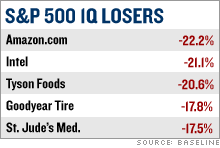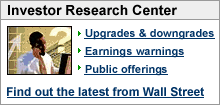|
Markets close the best first quarter in years
Blue-chips slip, but S&P posts biggest first quarter gain since '99; the Nasdaq's best since 2000.
NEW YORK (CNNMoney.com) - Blue chips slipped Friday, at the end of one of the best first quarters for the major gauges in years. The Dow Jones industrial average (down 41.38 to 11,109.32, Charts) lost 0.4 percent. For the quarter, it gained around 3.6 percent. That was its best first-quarter performance since 2002, when it gained 3.8 percent.
The Nasdaq composite (down 1.03 to 2,339.79, Charts) ended the session little changed, and the quarter up around 6 percent. It was the tech-fueled index's best first-quarter gain since 2000, when it rose 12.3 percent. The Standard & Poor's 500 (down 5.42 to 1,294.83, Charts) index lost 0.4 percent. It ended the quarter up 3.8 percent, its best first-quarter performance since 1999, when it added 4.7 percent. Treasury prices were little changed, after hitting a 22-month high in the previous session. Bond yields have been surging since Tuesday, when the Federal Reserve opted to boost a key short-term interest rate and hinted that it would need to keep doing so for the foreseeable future. While concerns about interest rates are bound to remain in place next week, stocks could benefit from some early quarter and early April seasonal strength. Earnings are also about to start pouring in a few weeks, and anticipation of strong earnings should support stocks in the short term, said Peter Cardillo, chief market analyst at S.W. Bach & Co. Longer term, the market may have trouble moving above recent highs. Stocks rose Friday morning as investors took in supportive reads on inflation and consumer sentiment, but the tone was negative by the early afternoon. "The market is settling down some. It's a normal retracement after stocks have moved well above their short-term support levels," said Eugene Peroni, senior managing director at Claymore Advisors. The Nasdaq hit a five-year high Wednesday, and blue chips have approached their highest level since May 2001 in recent weeks. Oil prices declined, but still ended the session near $67 a barrel. "The economic numbers have been neutral to positive, but it's the end of the quarter and the market is not responding to the drop in oil and drop in gold," Cardillo said. What moved?
Around two out of three Dow industrial components fell on the session. Verizon Communications (down $0.43 to $34.06, Research), Altria (down $0.86 to $70.86, Research) and Intel (down $0.24 to $19.46, Research) all lost at least 1 percent. Intel was one of many chip stocks sliding on the day. The Philadelphia Semiconductor (down 5.86 to 499.65, Charts) index, or the SOX, fell 1.2 percent. Oil stocks fell across the board, with the Philadelphia Oil Service Sector (Charts) index losing 1.7 percent and the Amex Oil (down 10.85 to 1,070.55, Charts) index falling 1 percent. General Motors (up $0.21 to $21.27, Research), a Dow 30 component, staged a comeback by the close, after sliding nearly 2 percent in the morning. Delphi, GM's parts supplier, filed motions in bankruptcy court to void its union contracts and said it was closing all but eight of its U.S. plants and looking to shed 28,000 workers. The move raised questions about whether GM might have to file for bankruptcy (Full story.) A few other Dow stocks also showed strength, including Honeywell (up $0.43 to $42.77, Research) and Hewlett Packard (up $0.33 to $32.90, Research). Market breadth was mixed. On the New York Stock Exchange. Losers barely topped winners on volume of 1 billion shares. On the Nasdaq, advancers edged out decliners as 1.3 billion shares exchanged hands. Treasury prices edged higher, lowering the benchmark 10-year yield to 4.85 percent, from 4.86 percent late Thursday. On Thursday, the 10-year note yield touched 4.88 percent during the session, the highest since May 2004. Bond prices and yields move in opposite directions. U.S. light crude oil for May delivery fell 52 cents to settle at $66.63 a barrel on the New York Mercantile Exchange. Inflation mild, consumer sentiment up
A number of positive economic reports helped fuel modest gains in early trading. Personal income rose 0.3 percent in February, the government reported. Economists surveyed by Briefing.com thought it would rise 0.4 percent. Income rose 0.7 percent in January. Personal spending rose 0.1 percent in February, versus forecasts for no change. Spending rose a revised 0.8 percent last month. The report also showed a mild inflationary environment. The "core" PCE price index, the report's inflation component, rose 0.1 percent, in line with estimates. The University of Michigan's revised consumer sentiment index, released after the start of trade, rose to 88.9 from an earlier read of 86.7. Economists surveyed by Briefing.com thought it would rise to 86.9. The Chicago PMI, a regional read on manufacturing, rose to 60.4 in March from 54.9 in February. Economists thought it would rise to 57.0. An exception was the February read on factory orders, which rose a smaller-than-expected 0.2 percent. Orders fell a revised 3.9 percent in January. ____________
For more on the markets, click here. |
|






